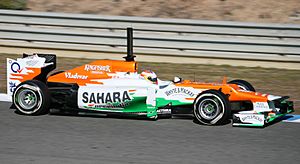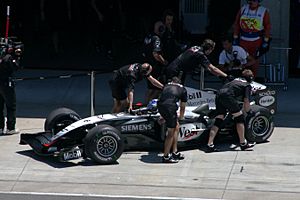Mercedes AMG High Performance Powertrains facts for kids
| Subsidiary | |
| Founded | 11 October 1983 (as Ilmor) |
| Founder | Mario Illien Paul Morgan |
| Headquarters |
Brixworth, Northamptonshire
,
United Kingdom
|
|
Area served
|
Worldwide |
|
Key people
|
|
| Parent | Mercedes-Benz AG |
Mercedes AMG High Performance Powertrains (HPP) is a company that builds powerful engines for Formula One race cars. It is owned by Mercedes-Benz. HPP is known for creating some of the fastest and most reliable engines in Formula One history.
This company has supplied engines to many famous F1 teams. These include McLaren, Force India, Williams, and the official Mercedes factory team. Their engines have helped teams win many championships. They have won eleven Formula One Drivers' Championships. They also won eleven Formula One Constructors' Championships. Besides F1, HPP also makes special engines for the Mercedes-AMG ONE sports car.
Contents
How HPP Started
The company began in 1983. It was first called Ilmor. It was started by two engineers, Mario Illien and Paul Morgan. The name "Ilmor" came from parts of their last names.
Ilmor first built engines for IndyCars. These are another type of fast race car. Later, in 1993, Daimler-Benz (which became Daimler) bought a part of Ilmor. By 2005, Daimler owned the whole company. They changed its name several times. Finally, in December 2011, it became Mercedes AMG High Performance Powertrains. This happened when the Mercedes F1 team also changed its name.
A small part of the original Ilmor company, which worked on special projects, became a separate company. It is now called Ilmor Engineering Ltd again. It is completely independent of Mercedes.
HPP's Formula One Journey

Ilmor first joined Formula One in 1991. They supplied engines to the Leyton House team. In 1992, they also supplied engines to the Tyrrell Racing team. Their engines helped these teams score points.
In 1993, Ilmor made engines for the Sauber team. Mercedes-Benz was involved, but the engines were officially called "Saubers." The Sauber team did surprisingly well. This convinced Mercedes to officially join Formula One in 1994.
Partnering with McLaren

In 1995, Ilmor became the main engine partner for McLaren. This was a very successful partnership. They won their first race together in 1997. Mika Häkkinen won the Drivers' Championship in 1998 and 1999. The team also won the Constructors' Championship in 1998. Later, in 2008, Lewis Hamilton won the Drivers' Championship with a Mercedes-powered McLaren.
Sadly, in 2001, Paul Morgan passed away in a plane accident. After this, Mercedes-Benz increased its ownership in Ilmor. The company was then renamed Mercedes-Ilmor Ltd.
Modern Hybrid Engines
In 2014, Formula One introduced new rules for engines. Mercedes created a new type of engine. It was a 1.6-litre turbocharged V6 engine. It also used a special hybrid system. This system recovered energy from braking and heat.
This new Mercedes engine was very powerful. Mercedes-powered cars quickly gained a big advantage. Since 2014, Mercedes engines have been incredibly successful. They have helped cars get pole position in many races. They have also won many races.
Helping During the Pandemic
In March 2020, during the COVID-19 pandemic, Mercedes HPP helped out. They worked with a university to make breathing aids. These devices helped patients stay out of intensive care. Mercedes HPP designed a device in just one week. They started making hundreds of these devices every day. They used the same machines that usually make parts for Formula One engines.
Formula One Engine Success
Mercedes HPP engines have powered many teams to victory. Here is a summary of their success with different teams:
| Constructor | Season(s) | Total wins | WCC | WDC | First win | Last win |
|---|---|---|---|---|---|---|
| 1994 | 0 | – | – | |||
| 1995–2014, 2021–2025 | 78 | 2 (1998, 2024) | 3 (1998–1999, 2008) | 1997 Australian Grand Prix | 2025 Hungarian Grand Prix | |
| 2009 | 8 | 1 (2009) | 1 (2009) | 2009 Australian Grand Prix | 2009 Italian Grand Prix | |
| 2009–2018 | 0 | – | – | |||
| 2010–2025 | 106 | 8 (2014–2021) | 7 (2014–2020) | 2012 Chinese Grand Prix | 2025 Canadian Grand Prix | |
| 2014–2025 | 0 | – | – | |||
| 2015 | 0 | – | – | |||
| 2016 | 0 | – | – | |||
| 2018 | 0 | – | – | |||
| 2019–2020 | 1 | 2020 Sakhir Grand Prix | 2020 Sakhir Grand Prix | |||
| 2021–2025 | – | – | ||||
| Total | 1994–2025 | 193 | 11 | 11 | 1997 Australian Grand Prix | 2025 Hungarian Grand Prix |
Types of Formula One Engines
Over the years, Mercedes HPP has developed many different engines for Formula One. These engines have changed as the rules of the sport have evolved.
| Season | Name | Type | Approximate power | Notes |
|---|---|---|---|---|
| 1994 | Mercedes-Benz 2175B | 3.5 L V10 | 537-563 kW (720-755 hp) | Built by Ilmor |
| 1995 | Mercedes-Benz FO 110 | 3.0 L 75° V10 | 690 hp (515 kW) | |
| 1996 | Mercedes-Benz FO 110D | 720 hp (537 kW) | ||
| 1997 | Mercedes-Benz FO 110E | 740-760 hp (552-567 kW) | ||
| 1998 | Mercedes-Benz FO 110G | 3.0 L 72° V10 | 800 hp (597 kW) | |
| 1999 | Mercedes-Benz FO 110H | 810 hp (604 kW) | ||
| 2000 | Mercedes-Benz FO 110J | 815 hp (608 kW) | ||
| 2001 | Mercedes-Benz FO 110K | 830 hp (619 kW) | ||
| 2002 | Mercedes-Benz FO 110M | 3.0 L 90° V10 | 845 hp (630 kW) | |
| 2003 | Mercedes-Benz FO 110P | 850 hp (634 kW) | ||
| 2004 | Mercedes-Benz FO 110Q | 870 hp (649 kW) | ||
| 2005 | Mercedes-Benz FO 110R | 930 hp (694 kW) | ||
| 2006 | Mercedes-Benz FO 108S | 2.4 L 90° V8 | 750 hp (559 kW) | |
| 2007 | Mercedes-Benz FO 108T | 810 hp (604 kW) | ||
| 2008 | Mercedes-Benz FO 108V | 750-800 hp (559-597 kW) | ||
| 2009 | Mercedes-Benz FO 108W | 750 hp (559 kW) + KERS | ||
| 2010 | Mercedes-Benz FO 108X | 750 hp (559 kW) | ||
| 2011 | Mercedes-Benz FO 108Y | 750 hp (559 kW) + KERS | ||
| 2012 | Mercedes-Benz FO 108Z | 750 hp (559 kW) + KERS | ||
| 2013 | Mercedes-Benz FO 108F | 750 hp (559 kW) + KERS | ||
| 2014 | Mercedes-Benz PU106A | 1.6 L 90° V6 turbo hybrid | 630 kW (845 hp) | |
| 2015 | Mercedes-Benz PU106B | 649 kW (870 hp) | Adapted for use in the Mercedes-AMG ONE | |
| 2016 | Mercedes-Benz PU106C | 670 kW (898 hp) | ||
| 2017 | Mercedes-AMG M08 EQ Power+ | 949 hp (708 kW) | ||
| 2018 | Mercedes-AMG M09 EQ Power+ | 1000 hp (746 kW) | ||
| 2019 | Mercedes-AMG M10 EQ Power+ | 1000 hp (746 kW) | Also known as "BWT Mercedes" for Racing Point | |
| 2020 | Mercedes-AMG M11 EQ Performance | 1025 hp (764 kW) | ||
| 2021 | Mercedes-AMG M12 E Performance | 1070 hp (798 kW) | ||
| 2022 | Mercedes-AMG M13 E Performance | 1070 hp (798 kW) | ||
| 2023 | Mercedes-AMG M14 E Performance | |||
| 2024 | Mercedes-AMG M15 E Performance | |||
| 2025 | Mercedes-AMG M16 E Performance |
See also
 In Spanish: Mercedes-Benz en Fórmula 1 para niños
In Spanish: Mercedes-Benz en Fórmula 1 para niños
- Mercedes-Benz in motorsport


